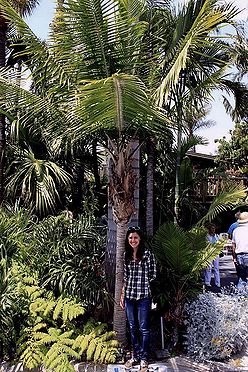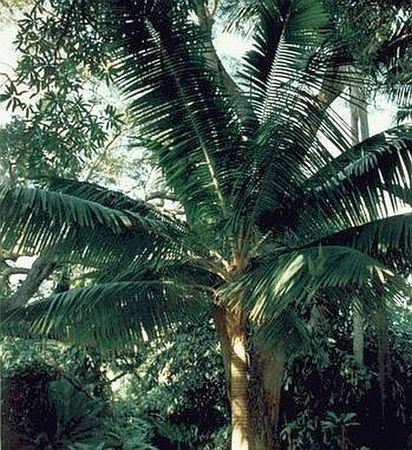Difference between revisions of "Ravenea moorei"
| Line 45: | Line 45: | ||
image:Ravenea_moorei2z.jpg|Photo, Palm-trees.org. | image:Ravenea_moorei2z.jpg|Photo, Palm-trees.org. | ||
image:RmIMG_7226.jpg|Ralph Velez's garden in Orange County, CA. Ravenea Moorei behind Jason's wife and Ravenea Hildebrandii to her right. Photo by Jason Dunn. | image:RmIMG_7226.jpg|Ralph Velez's garden in Orange County, CA. Ravenea Moorei behind Jason's wife and Ravenea Hildebrandii to her right. Photo by Jason Dunn. | ||
| − | |||
File:Raveneas1.jpg|San Diego, CA. Ravenea moorei & hildebrantii. Photo by Vince. | File:Raveneas1.jpg|San Diego, CA. Ravenea moorei & hildebrantii. Photo by Vince. | ||
| + | image:RmDSCF1566.jpg|"The top balcony allows a unique view of the tropical canopy, this is the spreading palms of Ravenea moorei." Palm House, Royal Botanic Gardens, Kew. photo by Bertie Bainbridge. | ||
| + | |||
</gallery></center> | </gallery></center> | ||
==External Links== | ==External Links== | ||
Revision as of 23:21, 22 December 2016
| Ravenea (rah-vehn-EH-ah) moorei (moor'-ee) | |||||||
|---|---|---|---|---|---|---|---|
 Ralph Velez's garden in Orange County, CA. Ravenea Moorei behind Jason's wife and Ravenea Hildebrandii to her right. Photo by Jason Dunn. | |||||||
| Scientific Classification | |||||||
| |||||||
| Synonyms | |||||||
|
| |||||||
| Native Continent | |||||||
|
| |||||||
| Morphology | |||||||
| |||||||
| Culture | |||||||
|
| |||||||
| Survivability index | |||||||
|
| |||||||
| Common names | |||||||
|
| |||||||
Contents
Habitat and Distribution
Endemic to the Comoros. Comoro Islands: Grande Comore. Secondary submontane rainforest; 500-800 m.Description
Robust tree palm. TRUNK to 20 m, 11-35 cm in diam., with a hemispherical base up to 105 cm across and some 40 cm high, diameter near the crown about 13 cm (from a photo), scars visible, internodes about 20 cm long in the lower trunk, much shorter towards the apex; nodal scars not very prominent; bark grey-brown; base of crown bulbous. LEAVES 11-19 in crown, porrect or spreading, straight, held on edge in distal half, 2.26-3 m long; sheath up to 60 x 19.5 cm, soon splitting, margins with long fine fibers, abaxial surface covered with thick tomentum, white in unexposed areas, turning brown on exposure, becoming thinner distally; petiole 10-25 cm long, 2.4-4.5 cm wide, 1-1.5 cm thick, adaxially flattened, abaxially ± rounded, sparsely tomentose abaxially, glabrous adaxially; rachis 1.3-2.4 m long, abaxially rounded, adaxially shallowly grooved or keeled (keel to 10 mm wide, narrowing in the more distal part to a sharp narrow keel), laterally grooved, sparsely tomentose to whitewaxy abaxially, in mid-leaf 1.7-2 x 1.2 cm across; leaflets 60-80 on each side of the rachis, the proximal very crowded, 15-54 x 0.8-1.7 cm, median 49-70 x 2-2.5 cm (interval 2.5-2.8 cm), distal 12-43 x 0.4-1.7 cm, main veins about 5, the midrib the largest, prominent adaxially, abaxially bearing a few conspicuous, close, regularly arranged large pale ramenta, transverse veinlets obscure, caducous tomentum present abaxially near the base. STAMINATE INFLORESCENCE solitary (only known dead) about 90 cm long, branched to 2 orders; peduncle about 35 cm long, 1.5 cm across, rounded in cross section, bracts not known; rachillae numerous, slender, up to 15 cm 1.5 mm. PISTILLATE INFLORESCENCE solitary, about 1.5 m long, spreading or pendulous, branched to 1 order; peduncle 60-90 cm, ellipsoid in cross-section, proximally 1.9-2 x 12 mm, distally about 15 x 11 mm, green with caducous, soft brown tomentum; prophyll tubular, 2-keeled, about 20 x 5 cm, rather thin, bearing caducous pale brown tomentum, tattering and becoming fibrous with age; peduncular bracts with the longest one about 130 x 5 cm; rachis about 60 cm long, glabrous and dotted; rachillae numerous, about 100, rather stiff, straight, glabrous, green, the proximal ones 30-47 cm with flattened base 7 x 3.5 mm, the distal ones 15-20 cm; bracteole at lowermost rachilla ovate and attenuate, about 45 x 11 mm, pedicels 0.5-5 x 1-1.5 mm; pistillate flowers not known. FRUIT yellow to orange, globose, about 16 mm (when dry 11-14 mm), one-seeded, stigmatic remains lateral to sub-basal, persistent sepals triangular, about 1.2 x 1 mm; persistent petals similar but smaller; epicarp smooth, wrinkling on drying, mesocarp fleshy, about 1.3 mm thick, endocarp not differentiated. SEED spherical, 9-11 mm in diameter, dark brown. (J. Dransfield and H. Beentje. 1995)/Palmweb. Editing by edric.
Probably closely related to R. robustior of Madagascar. (J. Dransfield and H. Beentje. 1995).
Culture
Comments and Curiosities
This is a dioecious genus.
One of the two Comoro Ravenea species; this is the larger of the two, the other (R. hildebrandtii) is much smaller. Before 1986 this palm was grown under the name R. hildebrandtii, but that taxon is almost unknown in cultivation outside Fairchild Tropical Garden. The species is named after Professor H.E. Moore, the great expert on palms, who collected the type. (J. Dransfield and H. Beentje. 1995)/Palmweb.
Conservation: IUCN Redlist - Critically Endangered. Seed of this species was collected by DeArmand Hull in October 1993 at the north end of Grand Comore at c. 500 m, above Mitsamouli; only two female trees were seen by Mr. Hull. He considers them highly endangered due to continuing agricultural pressure on the forest in this area. Only two female palm trees are known from a patch of forest last seen in October 1993 (J. Dransfield and H. Beentje. 1998)/Palmweb.
This is a tillering palm, it exhibits saxophone style root growth (it has a heel), keep top third of heel above soil elevation!
- IMAGE GALLERY
External Links
- Glossary of Palm Terms
- MODERN BOTANICAL LATIN
- "Just To Be Clear"
- THE SAXOPHONE STYLE ROOT GROWTH (HEEL)
- e-taxonomy.eu
References
Phonetic spelling of Latin names by edric.
Special thanks to Geoff Stein, (Palmbob) for his hundreds of photos.
Special thanks to Palmweb.org, Dr. John Dransfield, Dr. Bill Baker & team, for their volumes of information and photos.
Glossary of Palm Terms; Based on the glossary in Dransfield, J., N.W. Uhl, C.B. Asmussen-Lange, W.J. Baker, M.M. Harley & C.E. Lewis. 2008. Genera Palmarum - Evolution and Classification of the Palms. Royal Botanic Gardens, Kew. All images copyright of the artists and photographers (see images for credits).
Dransfield, J. & Beentje, H. 1995. The Palms of Madagascar. Royal Botanic Gardens, Kew and The International Palm Society.
Many Special Thanks to Ed Vaile for his long hours of tireless editing and numerous contributions.









